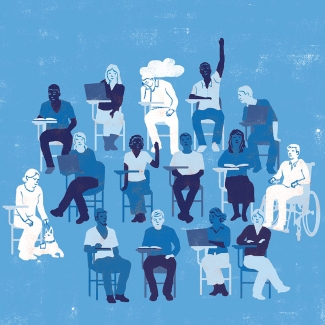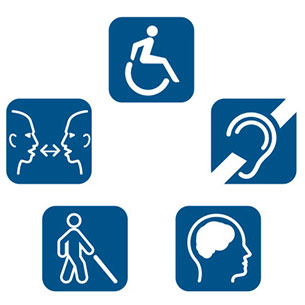
Students with documented disabilities are guaranteed equal access to an education and protection against discrimination on the basis of their disability. These rights are somewhat different than what they may have experienced in their pre-K through 12 grades.
The Health and Wellness section of the website provides general information about mental and physical health and offers suggestions for talking to students about sensitive issues. This section explains some of those differences and offers information on the following topics:
- Differences between high school and college accommodations
- Students on the Autism Spectrum
- How Parents Help
Differences Between High School and College Accommodations
When students with disabilities make the transition from high school to college, they find some differences in the services and accommodations they can expect. Through completion of high school, federal law requires that schools provide special instruction and allow for alteration of courses to support student success. Parents are involved with planning and implementing their student’s Individualized Education Program (IEP).
At the college level, there are no IEPs. Institutions abide by the Americans with Disabilities Act as Amended (ADAAA). They are required to provide equal access for people with disabilities, and they must offer protection against discrimination. Students are guaranteed to receive access to the courses, activities, and facilities they otherwise qualify for. Colleges are not required to modify course and program requirements for students with a disability, but they must provide reasonable and appropriate accommodations.

Students do not have to declare their disability when they apply to or when they start college, and some choose not to. However, if they want to qualify for accommodations, they must establish eligibility with the college’s office for disability services. It can take time for documentation to be collected and reviewed, and it makes sense to register before beginning classes. They can decide later if they want to use any accommodations, but if they’re not already registered with the disability office, there can be a significant delay while their eligibility is assessed.
The first step is to contact the office to determine what documentation is needed. This may vary depending on the college, the student’s disability, or needed accommodations. It may include high school records on any successful accommodations and past documentation on the student’s strengths and limitations. Students may be required to provide an updated evaluation of the disability and suggested services, which might mean an appointment with a medical professional who can verify the condition.
Accommodations are determined on a case-by-case basis. The student works with the disability office to identify “reasonable accommodations,” which might be extra time for testing, a notetaker for class lectures, a handicapped accessible residence hall room. For academic accommodations, students will receive a letter outlining the accommodation needed. The letter will likely be updated each semester, and students will need to provide a copy of the letter to their instructor. Letters do not identify a specific disability, only the accommodation needed. Often students find it helpful to meet with the instructor and explain the disability.
While students with disabilities are entitled to accommodations to help them navigate their education, at the college level, those accommodations are expected to fit within the core curriculum of the program the student is studying. A student who has difficulty speaking in front of a group still has to fulfill the coursework for a curriculum that requires classes in public speaking.
Throughout college, students are expected to advocate for themselves. The school will not disclose information to parents about the student’s condition, accommodations, or use of services, unless the student grants permission for parents to receive that information.
Students on the Autism Spectrum

Until fairly recently, it was unusual for students with Autism Spectrum Disorder (ASD) to attend college. Increasingly, however, students with ASD are seeking post-high school education, and some colleges and universities are developing programs and services specifically to help them succeed (Jackson, Hart & Volkmar, 2018).
All students face challenges transitioning to college. Most students worry about—and struggle with—time management, self-advocacy, and social adjustment or making friends. Students with ASD, however, can experience higher levels of stress and anxiety as they encounter those predictable challenges, and some may have difficulty expressing what they’re feeling, identifying what they need, and figuring out how to overcome the challenges.
It’s not uncommon for students with ASD to decide they don’t want to identify their diagnosis or seek special services. They may believe they have overcome the condition, and they no longer want “labels” applied to them. This is understandable, but the stresses of leaving home, making new connections, being more responsible for themselves, along with the heightened expectations of college academics can all converge and intensify their condition. Whether they take advantage of support services or not, it is important for the Disability Services office on campus to have a record of their diagnosis so that they can receive assistance if they should need it.
How Parents can Help
For families that have been deeply involved with their student’s educational plan throughout the pre-K to 12 years, the distance and lack of routine communication at the college level can be difficult. You’re no longer engaged in developing an Individualized Education Program. You can’t go online and check grades and assignments, and your student’s instructors are not going to call you if any problems crop up.
Part of the IEP during your student’s 11th- and 12th-grade most likely included working on self-advocacy. Leading up to the beginning of college, parents can coach their student on those self-advocacy lessons. Let your student plan out a schedule and manage his time, and let him handle the consequences if he makes mistakes.

Be sure your student can comfortably describe his or her condition and understands the challenges as well as the gifts that condition presents. Encourage practice on talking about any assistance or services required. Talk about whether it will help roommates, friends, and professors if they understand the condition. Be sure your student is contacting the disability office to set up an in-person or online meeting to discuss the student’s diagnosis, what documents or forms are needed, and what accommodations might be available. Ask your student if you should be in that meeting. If you go, be sure that any questions or comments are directed to your student, not you, and that the answers are coming from your student.
Work with your student to develop a list of questions for the disability office. Aside from finding out how to register for services, your student might want to know if there are other students with similar conditions; what kind of services those students use; what kind of challenges he might face; if there are any student organizations for students with disabilities; what advice the disability officer has.
After the meeting, parents can ask students how they feel about how things went. Do they feel like they got the answers they needed? Do they know what to do next? Would they be willing to meet with the disability officer again? Do they feel like they’re ready to start college?
As students make the transition to college, parents’ roles shift a bit, but the relationship doesn’t end. Parents should stay in touch…but not too much. Texts, phone calls, video chats, or visits should be focused on the positive, and parents are encouraged to expect success and look for the good signs. By communicating high expectations and positive praise, parents give their students confidence that they can succeed and are thriving.
Rather than step in and solve problems along the way, parents can ask their students to develop solutions by
- Identifying the problem–clearly stated, what is the problem?
- Gathering information–what do you need to know in order to solve the problem?
- Consulting with others–who needs to be involved or might be especially helpful?
- Identifying possible solutions–what might work?
- Determining which of the possible solutions has the best chance for success
- Making a choice
- Taking action
- Afterwards, evaluating whether the process was successful
Reference: Jackson, Scott L.J.; Hart, Logan; Volkmar, Fred R. “Preface: Special Issue—College Experiences for Students with Autism Spectrum Disorder.” Journal of Autism and Developmental Disorders. HTTPS://DOI.ORG/10.1007/S10803-018-3463-7. Accessed 5/21/2019.

